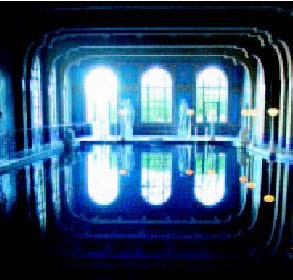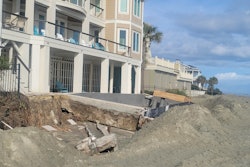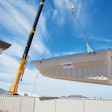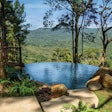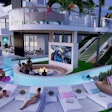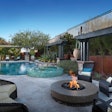
AQUA Editor Kirstin Pires traveled from Madison, Wis., to Morro Bay, Calif., last fall to attend the Genesis 3 Level I Design School, and lived to tell about it.
Thursday, October 28, 2004, Morro Bay, Calif., 57 degrees; a Pacific breeze stirs up scents of cedar, jasmine and salt spray. Whatever happens next, I'm just happy to be here and breathe this air. "Here" is The Inn at Morro Bay, a splash away from the teeming, ecologically significant Morro Bay Estuary and next door to a rookery preserve for cormorants, egrets and herons. "Here" is the Genesis 3 Level I Design School, the most advanced, respected, sought-after and all-encompassing design school in the industry.
I arrived the night before, and with my head still foggy from three nights and one missed connection I joined my classmates and the Genesis 3 faculty for a wine tasting and dinner on the deck overlooking the bay. Six wineries brought selections of their Central Coast offerings, from crisp Chardonnays to typical, big zinfandels. The winemakers poured samples, made suggestions and enthusiastically answered questions from the most basic ("I've never been to a wine tasting, what do I do.") to the more esoteric ("What is the percentage of meritage in this blend."). Genesis 3's food and wine guy, Brian Van Bower, was clearly in his element and enjoyed sharing his find. "Central Coast wines are so under-rated," said the president of Aquatic Consultants in Miami. "In a few years, this area will be like Napa, with prices to match."
I know just enough about wine to know that I don't know very much about wine, but I wondered what other students thought — aside from the obvious enjoyment and high spirits. Months later, I talked to several classmates and found that the wine tasting had made a lasting impression.
"The wine education was helpful; it was fun to do, and it's something that I've never had the opportunity to do," said Alan Eng from Sunset Pool Contractors in Tracy's Landing, Md., "One of my customers is really big on wine, and we had a conversation about it. Actually, it's funny that you should ask," he told me, "I'm going to a wine tasting with him tomorrow. I've always tried to go for the upper-crust of the client base, and the G3 knowledge base gives us credibility."
School Is In Session
I've heard the self-described "Three Pigs" of Genesis 3 speak at the AQUA Show on several occasions, and I've interviewed Bower as well as his two Genesis 3 partners, Skip Phillips and David Tisherman, so I knew that their program was about lifestyle as well as designing and building pools.
As Bower worked the crowd and I watched builders and service guys sample wines, ask questions and sign up for case clubs, I realized that this wasn't just a reception, but that Level I Design School was underway. And in typical Genesis 3 fashion, you don't start by dipping a toe in to test the water, you start with a shout and a cannonball.
Living The Life
The next morning, formal classes began. As I looked at the schedule, I wondered when I was going to be able to fit in a short run. It looked like there might be an hour of free time between the end of Ron Lacher's structural engineering presentation and our trip to Paso Robles where we'd enjoy a private dinner in the caves of the Eberle Winery. I made a mental note to try to sit at Bower's table because he'd have the best wine.
Genesis 3 Design School is not Pool-Building 101. The students are typically pool builders or professionals in allied industries like construction or landscaping. They know how to build a pool. But most importantly, they know — or at least suspect — that there is a lot that they don't know. What they all have in common is a sense that they want more. More satisfaction from their work, more profit, more challenging projects, more resources at their fingertips, better design skills, better clients.
More out of life.
Clinging to cups of coffee, two dozen attendees gathered for the opening session of formal classes. The Three Pigs — Bower, Phillips and Tisherman — introduced an ambitious plan for the next three days and then left us alone with David Tisherman for three hours of drawing instruction.
This was a sharp contrast to the evening before. This was technical, mechanical three-D drawing. Tisherman stood ready to give us the skills we'd need to render design ideas in the field in front of clients. No computer drawing programs or shape templates, here, just pencils, straight edges and triangles.
I had to bite my tongue when some students wondered why they should learn to draw with so many computer programs available. My favorite — and most demanding — art professor in college was my grandfather, W. Dean Warnholtz. He was unwavering in his insistance on learning to draw, no matter how abstract one's art might eventually become. Drawing is how you learn to see; how you learn to represent the three-dimensional world in two dimensions. It will make you a better designer, he said. Becoming a better designer is what G3 is all about.
The rest of Thursday was similarly technical, with Larry Parmelee of Parmelee Geology discussing the soils issues associated with hillside construction, from the modest pool built on a gentle grade, to fantastical engineering feats that allow cantilevered watershapes to seemingly soar over steep ravines. Ron Lacher, familiar to most in the industry, followed with his structural engineering presentation.
Water Public And Private
Friday required another mental gearshift beginning with landscape architect Mark Holden's slide lecture on the history of pool and fountain design.
He started with perhaps the most celebrated manipulation of water to man's needs, the Roman aqueducts. We learned that the fantastical fountains throughout southern Europe that today draw tourists were originally built as public water sources, and are early examples of public-works projects. The form and function go hand-in-hand and create an inspirational reference point for modern builders.
At the Hearst Castle that afternoon we saw water that was in many respects the complete opposite. William Randolph Hearst's "ranch" in San Simeon represents water designed only for private use. And while the impressive pools are quite functional, the outdoor pool in particular is often held up as an example of architectural gibberish with it's use of incongruent historical styles and idiosyncratic, functionless decorations. For the G3 students, Hearst Castle was a case study for working with an eccentric and strong-willed client.
Relax, Renew, Retool
With heads stuffed full of new information, skills, facts, resources and formulas, most students would say the most valuable thing they took home from Morro Bay is hard to define. Call it confidence or optimism or pride — maybe all of those.
There were students who were ready to quit the business, students who were ready to take it up a notch. There were some who were starting out or returning to the business after a long absence. I'm pretty sure that every one of them found what they were looking for in Morro Bay.
Mark Johnson of Friendly Pool Service in Walnut Creek, Calif., had seemingly done it all. He'd taught NSPI tech classes, served in his regional NSPI chapter, been the president of IPSSA.
"I thought this would be the way to help me make the decision to either continue in the industry or get out, do something else," said Johnson. "I've had a service company for 15 years, I'm 62 and I'm looking at retirement. I was at the point where I was looking at selling my routes, and just do something else like maybe making cider or wine or beer or gardening, who knows? I was past the point of challenges because I'd fixed just about everything there is to fix."
With a builders' license and encouragement from friends who told him, "You have to go, you won't believe it, you'll really get a lot out of it," Johnson and his business partner, Andrew Jackson, reserved two spots in the Level I Design School.
"I definitely got totally remotivated," said Johnson. "I realized that we could do the work and it would be way more enjoyable.The challenges would be there, but we'd be able to make enough money doing quality jobs for quality people and not feel pressed to sell ourselves short. And therefore it would be a more rewarding career."
Alan Eng had an idea of where he wanted to take his company, but his "outside the box" thinking didn't impress the old-school builders in his neck of the woods. G3 confirmed that he had the right idea.
"I was always going in this direction, but these guys confirmed it, they gave me a boost. Now I have a reference point of someone who's done what I want to do. After seeing G3 at the AQUA Show last year, I was totally on fire, and it really motivated me to step it up many notches. And we have."
Eng feels a particular affinity with Brian Van Bower's way of doing business. "He has the same philosophy that I do. When I heard him speak, I thought, 'Hey, I'm not by myself!' said Eng. "I'm understanding where my clients are coming from, and their taste and I'm not afraid of a $3,000-to$5,000 upcharge, because money isn't the issue with them, it's quality and value."
Being at Morro Bay felt like being at a retreat for mind and body. The serenity and beauty of the setting, the extraordinary food and service and the collegiality of the student body put everyone in the best possible frame of mind to soak up the combined wisdom of the Design School faculty. Months later, the students I talked to are still feeding off the energy of Morro Bay.
